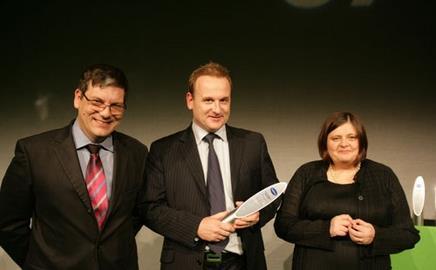Winner
Skanska
This Swedish contractor takes a very methodical and complete approach to sustainability, underpinned by a host of tools, training and monitoring strategies that ensure it is as green as possible. What is so commendable is having hit its targets it simply ups the ante and sets an even tougher target next time. A good example of this is its waste management system. This has improved waste recycling rates on its sites from 40% in 2003 to a very impressive 90% last year. Other strategies include a strict materials purchasing policy – for example, it has set a target of at least 10% recycled content in all its buildings and all timber used on its jobs must be accredited by the Forest Stewardship Council or the Programme for the Endorsement of Forest Certification. Monitoring helps the firm identify where resource use is high so it can take steps to reduce its impact. For example it monitors fuel, electricity and water use on its construction sites, in its offices and also the carbon footprint of its employees. It even has air-monitoring equipment on its huge Barts and London Hospital PFI to tackle the emissions from its plant. This is so sensitive it can even pick up pollen counts from Europe.Runners-up
Bovis Lend Lease
Like Skanska, Bovis Lend Lease takes a very thorough approach to sustainability that permeates its business. It has a sustainability plan that cuts through all aspects of the business including its supply chain, employees and even clients. It benchmarks all its projects for waste, energy and water consumption, timber and commercial vehicles using a simple traffic light system – green means it is doing well. Good examples include a 97% materials recycling rate at its Bankside project and 84% of all its recent projects having used FSC-certified timber. It has even developed a site hoarding made from recycled plastic to cut down on timber use.Carillion
Carillion has its sustainability performance externally verified against its targets and last year managed to hit a commendable 81.6%. It has done this by responsible procurement of timber, a supply chain partnership designed to improve the environmental performance of its suppliers and a framework agreement with a plasterboard supplier to take back its plasterboard waste. Carillion also minimises its environmental impact by recycling its office waste and has a target of reducing emissions from its vehicles by 10% this year.Wates
Waste is Wates’ big thing. It is taking it so seriously it has set itself a target of producing zero non-hazardous waste by 2010. All its sites have waste management plans backed up by a toolkit to help it reduce waste. It segregates waste on its sites wherever possible so it can be recycled, and also tries to find ways of recycling problem materials. For example it has invested in a special paint tin and tools washing unit that recovers paint solids. Theses are then sent back to the manufacturer to make into new paint.Sponsor
What does the table tennis ball share with the world‚Äôs most advanced single-ply roofing membrane? Both are innovative, enduring and perfectly formed - and invented by ∫⁄∂¥…Á«¯‚Äôs ‚Äò‚ÄôSustainability Awards 2007" sponsor FDT Flatroof Design Technology.
FDT has become a watchword for integrity and quality in a modern construction industry where environmental responsibility is paramount. That’s thanks to a century-long track record in research and innovation that included Europe’s first single-ply roofing membrane.
FDT’s "green"membrane, PIB-based Rhepanol, remains the ONLY single-ply membrane with first -class environmental credentials of a Life Cycle Assessment. Only 25% is oil-derived, with 75% from freely available mineral sources.
Sustainability Awards 2007
- 1
- 2
- 3
- 4
- 5
- 6
- 7
- 8
- 9
- 10
- 11
- 12
- 13
- 14Currently reading
Sustainable Contractor/Construction Manager of the Year
- 15
- 16
- 17

























